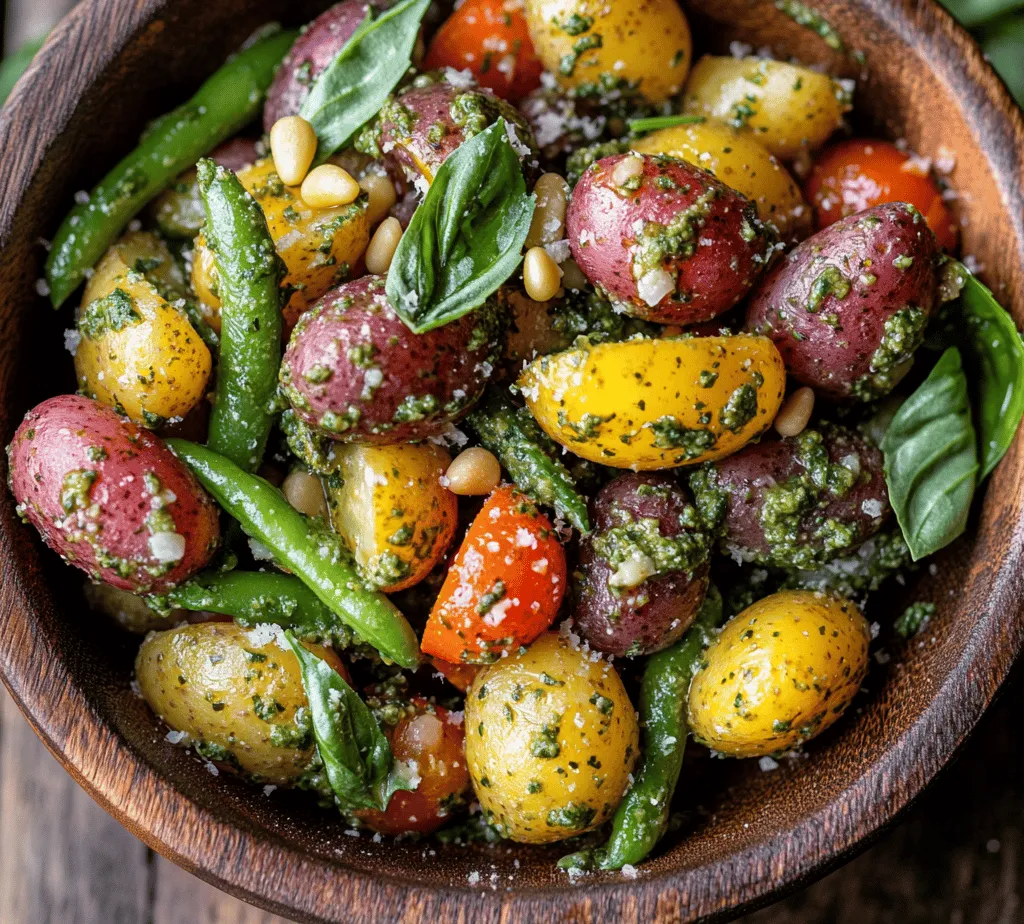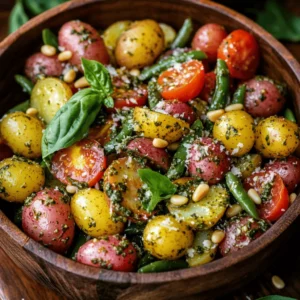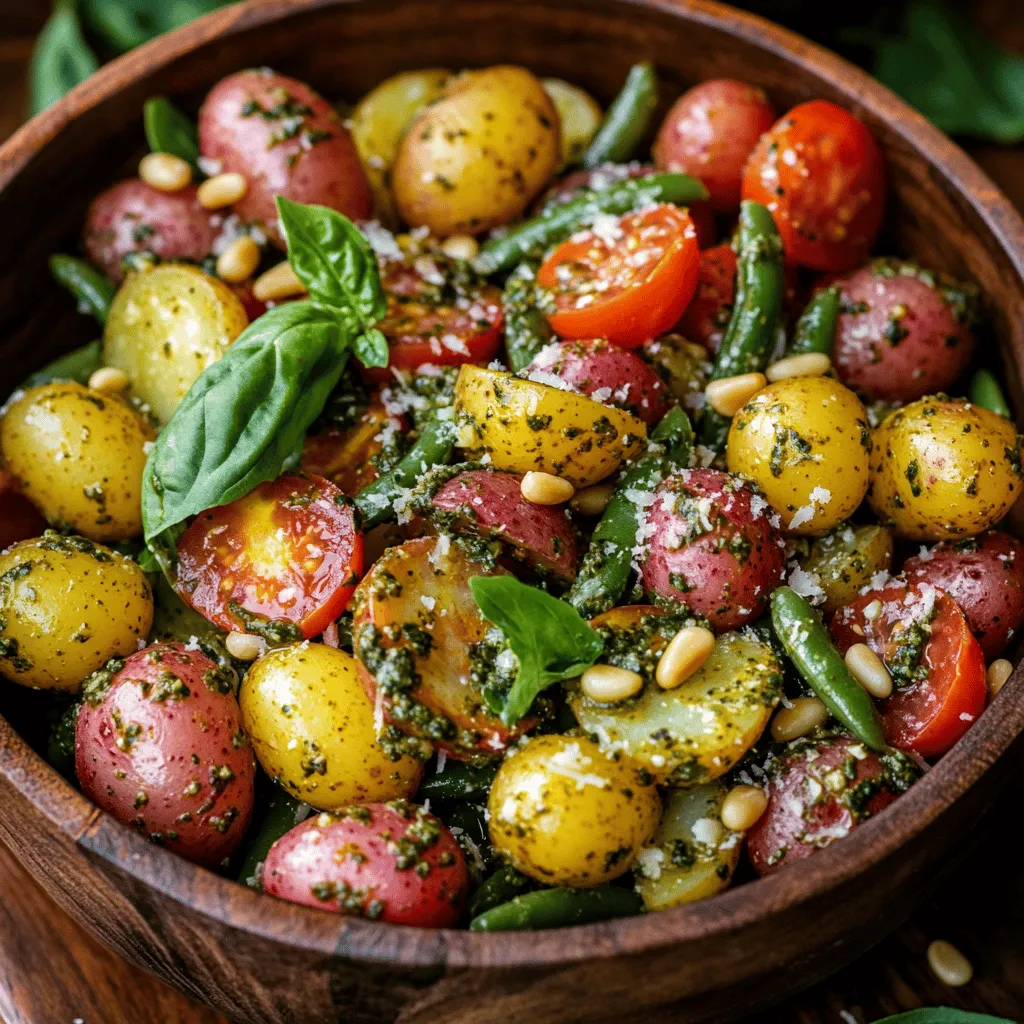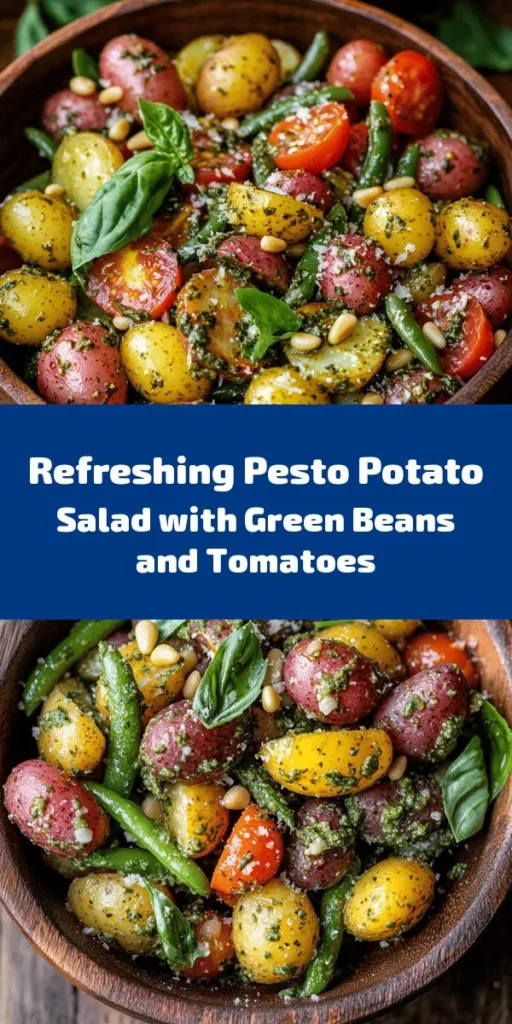Introduction
Pesto potato salad is a delightful and refreshing dish that combines the earthy flavor of potatoes with the vibrant, aromatic qualities of pesto. This dish is perfect for warm weather gatherings, picnics, and barbecues, where its bright flavors can shine alongside grilled meats or serve as a standalone vegetarian option. The combination of creamy potatoes and zesty pesto creates a unique flavor profile that is both satisfying and invigorating.
One of the most appealing aspects of pesto potato salad is its versatility. You can customize it to suit your taste preferences or dietary restrictions, making it a go-to recipe for various occasions. Whether you are hosting a summer potluck, looking for a side dish for your family dinner, or simply craving a healthy yet indulgent snack, pesto potato salad fits the bill. The freshness of its ingredients, from the vibrant basil in the pesto to the tender baby potatoes, makes this salad not just a dish, but an experience that captures the essence of seasonal cooking.
In this article, we will delve into the nuances of pesto potato salad, exploring its origins and the significance of its ingredients. We will also guide you through the steps to create this vibrant dish, ensuring you can recreate its deliciousness in your own kitchen.
Understanding Pesto Potato Salad
Introduction to Pesto as a Flavor Profile
Pesto is an Italian sauce that has taken the culinary world by storm. Traditionally made from fresh basil, garlic, pine nuts, Parmesan cheese, and olive oil, pesto serves as a versatile condiment that can enhance various dishes. Its bold and aromatic flavor profile complements not only salads and pasta but also sandwiches, grilled meats, and even pizza. The combination of fresh herbs, creamy cheese, and rich nuts creates a harmony of flavors that is both vibrant and comforting.
Origins of Pesto
Originating from Genoa, Italy, pesto has a rich history dating back to the Roman Empire when it was known as “moretum.” The modern version, known as pesto alla Genovese, emerged in the 19th century and has since become a staple in Italian cuisine. Its name derives from the Italian word “pestare,” which means to crush or pound, referring to the traditional method of preparing the sauce using a mortar and pestle. Today, pesto has evolved into various regional adaptations, featuring alternative herbs, nuts, and cheeses, further showcasing its versatility.
Traditional Ingredients and Variations
The classic ingredients in pesto contribute to its signature flavor, but variations abound. In addition to basil, other herbs like parsley, arugula, or cilantro can add unique twists to the sauce. Nuts can range from the traditional pine nuts to walnuts or almonds, each bringing its own texture and flavor. Cheese options can also vary, with some opting for pecorino or nutritional yeast for a dairy-free alternative. This adaptability makes pesto a favorite among home cooks and professional chefs alike.
The Role of Potatoes in the Dish
Potatoes serve as the perfect canvas for pesto, offering a hearty yet neutral flavor that complements the sauce beautifully. Their ability to absorb flavors means that each bite is infused with the aromatic essence of pesto. For this recipe, baby potatoes are often the preferred choice due to their tender texture and smaller size, making them easy to prepare and eat. Additionally, baby potatoes cook quickly and retain their shape well, contributing to the salad’s overall appeal.
Nutritional Benefits of Baby Potatoes
Baby potatoes, often referred to as new potatoes, are packed with nutrients. They are a great source of vitamins C and B6, potassium, and dietary fiber. These small spuds are low in calories, making them an excellent option for those seeking a healthy side dish. Their natural sweetness and creamy texture are enhanced when cooked, making them a delightful addition to any meal. When paired with pesto, the nutritional benefits are further amplified, providing healthy fats from the olive oil and nuts, as well as vitamins from the fresh basil.
Texture and Flavor Contributions
The combination of tender potatoes and the rich, creamy texture of pesto creates a delightful contrast in every bite. The smoothness of the sauce envelops the potatoes, while the added ingredients, such as cherry tomatoes and green beans, contribute bursts of freshness and color. This interplay of textures and flavors is what makes pesto potato salad not only a treat for the palate but also visually appealing, perfect for impressing guests at your next gathering.
Ingredient Breakdown
To create a delicious pesto potato salad, it’s essential to select the right ingredients. Below, we will break down each component of the dish, explaining their importance and offering tips for selecting the best options.
Baby Potatoes
When it comes to making pesto potato salad, baby potatoes are the star of the show. These small tubers are tender and flavorful, making them an ideal base for the dish.
Types of Potatoes to Use (Red vs. Yellow)
You can choose between red and yellow baby potatoes, both of which offer unique flavors and textures. Red potatoes are slightly waxy, holding their shape well when cooked, while yellow potatoes are creamier and have a buttery texture. For a delightful contrast, consider using a mix of both varieties, enhancing the visual appeal and flavor complexity of your salad.
Cooking Tips for Optimal Texture
To achieve the perfect texture, start by washing the baby potatoes thoroughly to remove any dirt. Then, boil them in salted water until fork-tender, which typically takes about 10-15 minutes depending on their size. Be cautious not to overcook them, as this can result in mushy potatoes. Once cooked, drain the potatoes and let them cool slightly before cutting them in half or quarters, depending on your preference. This method ensures that the potatoes retain their shape while allowing them to soak up the flavors of the pesto.
Fresh Basil Leaves
Fresh basil is the soul of any great pesto, providing a fragrant and aromatic base for the sauce.
Importance of Freshness in Pesto
Using fresh basil is crucial for achieving the vibrant flavor characteristic of authentic pesto. Dried basil lacks the essential oils and freshness that make the sauce come alive. When selecting basil, look for bright green leaves that are free from blemishes or discoloration.
Tips for Selecting and Storing Basil
To ensure you get the best quality basil, purchase it from a local farmer’s market or a grocery store with a good turnover of fresh herbs. If you’re growing basil at home, harvest it in the morning when the leaves are most fragrant. To store fresh basil, keep it in a glass of water at room temperature, covering the leaves loosely with a plastic bag to retain moisture. Alternatively, you can store basil in the refrigerator wrapped in a damp paper towel inside a plastic bag for up to a week.
Nuts in Pesto
Nuts play a vital role in enhancing the flavor and texture of pesto.
Pine Nuts vs. Walnuts: Flavor and Health Benefits
While traditional pesto often calls for pine nuts, walnuts are a popular alternative that offers a slightly different flavor profile. Pine nuts are buttery and sweet, while walnuts have a more robust, earthy taste. Both nuts are rich in healthy fats, protein, and antioxidants, making them excellent choices for a nutritious pesto.
Alternatives for Nut Allergies
For those with nut allergies, there are several alternatives to consider. Seeds such as sunflower seeds or pumpkin seeds can be used to create a nut-free pesto without sacrificing texture or flavor. These options are packed with healthy fats and nutrients, ensuring everyone can enjoy this delicious dish.
Dairy Choices: Parmesan vs. Nutritional Yeast
The cheese component in pesto can vary based on dietary preferences.
Flavor Profiles and Dietary Considerations
Parmesan cheese adds a savory, salty flavor to pesto, enhancing its overall richness. However, for those following a dairy-free diet, nutritional yeast is an excellent substitute. It provides a cheesy flavor while being low in calories and high in B vitamins.
How to Choose the Right Option for Your Needs
When selecting cheese or nutritional yeast for your pesto, consider the overall flavor profile you desire. If you’re looking for a traditional taste, opt for aged Parmesan. If you’re vegan or lactose intolerant, nutritional yeast is a fantastic choice that still delivers on flavor.
Other Key Ingredients
In addition to the main components, several other ingredients contribute to the overall flavor and nutrition of pesto potato salad.
Garlic: Health Benefits and Flavor Enhancement
Garlic is a quintessential ingredient in pesto, providing a sharp, pungent flavor that complements the basil beautifully. Beyond its taste, garlic is known for its numerous health benefits, including its potential to boost the immune system and promote heart health.
Extra Virgin Olive Oil: Quality and Cooking Tips
The quality of olive oil used in pesto can significantly impact the flavor. Extra virgin olive oil is the best choice, as it is cold-pressed and retains the most nutrients and flavor. When adding olive oil to your pesto, begin with a small amount and gradually adjust to achieve your desired consistency.
Lemon Juice: Balancing Flavors
A splash of lemon juice brightens the pesto, balancing the richness of the nuts and cheese. It also adds a refreshing acidity that enhances the overall flavor of the potato salad. Freshly squeezed lemon juice is preferred for its vibrant taste, but bottled lemon juice can suffice in a pinch.
Cherry Tomatoes and Green Beans: Adding Color and Nutrition
Adding cherry tomatoes and green beans to your pesto potato salad brings not only color but also additional nutrients. Cherry tomatoes provide sweetness and juiciness, while green beans add a satisfying crunch. Both ingredients enhance the salad’s visual appeal and contribute vitamins and minerals, making the dish even more wholesome.
Black Olives: Optional Ingredients for Added Complexity
For those who enjoy a briny flavor, black olives can be an excellent addition to pesto potato salad. Their salty taste adds complexity and depth, making each bite even more delightful. If you choose to include olives, opt for high-quality varieties like Kalamata or Gaeta for the best flavor.
In the next section, we will provide detailed instructions on how to prepare your pesto potato salad, ensuring you can bring this delicious dish to life in your kitchen. Stay tuned for a step-by-step guide that will make your cooking experience both enjoyable and rewarding.

Step-by-Step Instructions
Boiling the Potatoes
To prepare a delightful Pesto Potato Salad, begin by boiling your potatoes. Select medium-sized, waxy potatoes like Yukon Gold or red potatoes, as they hold their shape well. Start by washing the potatoes under cold water to remove any dirt or debris.
1. Place the potatoes in a large pot and cover them with cold water, ensuring the water level is about an inch above the potatoes.
2. Add a generous pinch of salt to the water to enhance the flavor of the potatoes during cooking.
3. Bring the water to a boil over high heat, then reduce to a simmer.
Importance of Boiling Time and Technique
Cooking time typically ranges from 15 to 20 minutes, depending on the size of the potatoes. It’s essential to avoid overcooking, as mushy potatoes will not hold up well in the salad.
Tips for Checking Doneness
To check for doneness, simply pierce a potato with a fork or a knife. If it slides in easily but the potato still offers slight resistance, it’s done. Drain the potatoes in a colander and let them cool slightly before cutting them into bite-sized pieces.
Preparing the Pesto
While the potatoes are cooling, prepare the fresh pesto. A food processor is the best tool for this task, ensuring a smooth and well-blended consistency.
1. In the food processor, combine 2 cups of fresh basil leaves, 1/3 cup of pine nuts, 2-3 cloves of garlic, and a pinch of salt.
2. Pulse these ingredients until they are finely chopped.
3. Slowly drizzle in 1/2 cup of extra virgin olive oil while the processor is running, allowing the mixture to emulsify and form a creamy paste.
Techniques for Achieving the Perfect Consistency
You may need to stop the processor and scrape down the sides to ensure all ingredients are incorporated. If the pesto is too thick, add a little more olive oil until you achieve your desired consistency.
Flavor Balancing: Adjusting Seasoning
Taste the pesto and adjust the seasoning as needed, adding more salt or a squeeze of lemon juice for acidity if desired. This balancing act is crucial for a well-rounded flavor profile that enhances the potato salad.
Blanching the Green Beans
While preparing the pesto, it’s time to blanch the green beans. This technique helps retain their vibrant color and crisp texture.
1. Bring a pot of salted water to a rolling boil.
2. Trim the ends of the green beans and add them to the boiling water. Blanch for 2-3 minutes until they are bright green yet still crisp.
Importance of Blanching for Color and Texture
Blanching not only enhances the color of the beans but also stops the cooking process, preserving their crunchy texture, which provides a delightful contrast to the tender potatoes.
Tips for Proper Ice Water Techniques
After blanching, immediately transfer the green beans to a bowl of ice water. This shock of cold water halts the cooking process and helps retain their vibrant hue. Let them sit for about 5 minutes before draining and patting dry.
Combining the Ingredients
Now that all components are prepped, it’s time to combine them into a harmonious salad.
1. In a large mixing bowl, add the cooled, cubed potatoes, green beans, and the prepared pesto.
2. Gently fold the ingredients together using a spatula.
Techniques for Folding Ingredients Together Without Mashing
Be careful not to stir too vigorously, as you want to maintain the integrity of the potato chunks. Instead, use a gentle folding motion to combine the ingredients evenly.
Visual Cues for Knowing When the Salad is Well-Mixed
The salad is ready when the potatoes and green beans are evenly coated in pesto, and the colors are vibrant. The dish should look inviting, with the green pesto contrasting beautifully against the golden potatoes and bright green beans.
Serving Suggestions
Presentation Ideas
When serving your Pesto Potato Salad, presentation matters. Consider using a large, shallow bowl that allows the colors to shine. You can also layer the salad for a more dramatic effect, placing potatoes on the bottom and topping with green beans and additional pesto.
Serving Warm, at Room Temperature, or Cold
This salad is versatile and can be enjoyed in various ways. Serve it warm for a comforting side dish, at room temperature for picnics, or chilled for a refreshing summer salad.
Garnishing Tips for Visual Appeal
Enhance the salad’s appearance with a sprinkle of toasted pine nuts or freshly grated Parmesan cheese on top. A few basil leaves placed artfully on the salad can also add an appealing touch.
Pairing Options
The Pesto Potato Salad pairs beautifully with grilled meats, such as chicken or fish. It also complements vegetarian dishes and works well as a side for barbecued fare.
Suggestions for Serving at Different Occasions
This salad is perfect for various occasions. Serve it at summer barbecues, family picnics, or potluck gatherings. It also makes for an elegant side dish at dinner parties or holiday meals, showcasing your culinary creativity.
Nutritional Value and Health Benefits
Overview of the Nutritional Content of the Salad
This Pesto Potato Salad is not only delicious but also nutritious. Potatoes provide a hearty base rich in vitamins C and B6, potassium, and dietary fiber. The added green beans contribute additional vitamins A and K, folate, and antioxidants, making this salad a wholesome choice.
Health Benefits of the Key Ingredients
– Potatoes: A great source of complex carbohydrates, potatoes offer sustained energy and are filling, making them a perfect addition to a balanced diet.
– Basil: This aromatic herb is rich in antioxidants and has anti-inflammatory properties, contributing to overall health.
– Olive Oil: Packed with healthy fats, particularly monounsaturated fats, olive oil is known for its heart health benefits and its role in reducing inflammation.
Vegan and Gluten-Free Adaptations
This Pesto Potato Salad is inherently vegan and gluten-free, making it suitable for a variety of dietary needs. For those looking to modify the recipe, consider using nutritional yeast in place of cheese for a cheesy flavor without dairy. Additionally, you can experiment with different nuts in the pesto, such as walnuts or cashews, for a unique twist.
Conclusion
This Pesto Potato Salad exemplifies versatility, combining flavors and textures that appeal to a wide range of palates. Its bright, fresh ingredients make it an ideal dish for any occasion, from summer barbecues to cozy family dinners.
Encouragement to experiment with variations adds excitement to the cooking process; try incorporating roasted vegetables or using different herbs in your pesto. This dish is not only delicious but also a canvas for your culinary creativity, inviting you to make it your own.
The joy of making and sharing this refreshing Pesto Potato Salad lies not only in its delightful taste but also in the memories created around the dining table. Enjoy the process, share the experience, and let this dish bring friends and family together for a nourishing meal.



